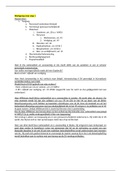Samenvatting
Summary of Statistics (IBC), Radboud University
- Instelling
- Radboud Universiteit Nijmegen (RU)
This is a summary of the 2nd year statistics course. It is a combination of the lecture and powerpoint notes, and the assigned chapters of the book. This will help you understand statistics; it helped me obtain a 7.6 on the final exam.
[Meer zien]














